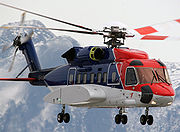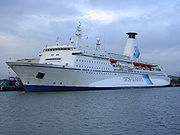
Sponson
Encyclopedia




Watercraft
A watercraft is a vessel or craft designed to move across or through water. The name is derived from the term "craft" which was used to describe all types of water going vessels...
, for protection, stability, or the mounting of equipment such as armaments or lifeboats, etc. They extend a hull dimension at or below the waterline
Waterline
The term "waterline" generally refers to the line where the hull of a ship meets the water surface. It is also the name of a special marking, also known as the national Load Line or Plimsoll Line, to be positioned amidships, that indicates the draft of the ship and the legal limit to which a ship...
and serve to increase flotation or add lift when underway.
Sponsons are commonly used on jetskis and other personal watercraft such as canoe
Canoe
A canoe or Canadian canoe is a small narrow boat, typically human-powered, though it may also be powered by sails or small electric or gas motors. Canoes are usually pointed at both bow and stern and are normally open on top, but can be decked over A canoe (North American English) or Canadian...
s to provide either additional buoyancy and thus stability against capsize, or hydrodynamic forces to resist capsize. They can often be easily attached to an existing craft in order to improve its stability.
They are far less common on ships than such stabilizing means as pontoons
Pontoon (boat)
A pontoon is a flotation device with buoyancy sufficient to float itself as well as a heavy load. A pontoon boat is a flattish boat that relies on pontoons to float. Pontoons may be used on boats, rafts, barges, docks, floatplanes or seaplanes. Pontoons may support a platform, creating a raft. A...
, outrigger
Outrigger
An outrigger is a part of a boat's rigging which is rigid and extends beyond the side or gunwale of a boat.In an outrigger canoe and in sailboats such as the proa, an outrigger is a thin, long, solid, hull used to stabilise an inherently unstable main hull. The outrigger is positioned rigidly and...
s, and dual hulls due to their comparatively poor performance in stabilizing large hulls. Sponsons are sometimes added to improve stability when ships are modified.
Sponsons are used on the fuselages of flying boat
Flying boat
A flying boat is a fixed-winged seaplane with a hull, allowing it to land on water. It differs from a float plane as it uses a purpose-designed fuselage which can float, granting the aircraft buoyancy. Flying boats may be stabilized by under-wing floats or by wing-like projections from the fuselage...
s, as pioneered by German aerospace engineer Claudius Dornier
Claudius Dornier
Claude Honoré Desiré Dornier born in Kempten im Allgäu was a German airplane builder and founder of Dornier GmbH...
during World War I. They take the form of a short wing which when travelling through the water provides hydrodynamic stability during take off and landing.
They are often used in larger helicopters where the internal space of the sponson can be used for fuel or to house landing gear without reducing cargo or passenger space in the fuselage as, for example, with the Sikorsky S-92
Sikorsky S-92
The Sikorsky S-92 is a four-bladed twin-engine medium-lift helicopter built by Sikorsky Aircraft for the civil and military helicopter market. The S-92 was developed from the Sikorsky S-70 helicopter and has similar parts such as flight control and rotor systems.The H-92 Superhawk is a military...
and the Bell 222
Bell 222
The Bell 222 is a twin-engined light helicopter built by Bell Helicopter. The Bell 230 is an improved development with different engines and other minor changes. A cosmetically modified version of the 222 was used as the titular aircraft in the US television series Airwolf.-Development:In the late...
.
By extension, the term "sponson" is sometimes used to describe similar projections from the sides of land vehicles, such as the World War I Mark I tank. In the case of the Bradley Fighting Vehicle, which doubles as a troop transport and armament platform, the sponson refers to the aspect of the vehicle body directly over the tracks and includes layers of hardened, bullet-proof materials to protect the occupants. It is also used as a storage space for both vehicle equipment and components, and either ammunition or crew belongings.

